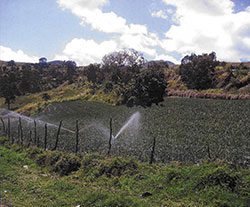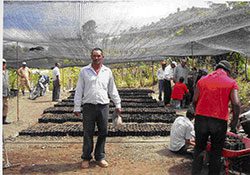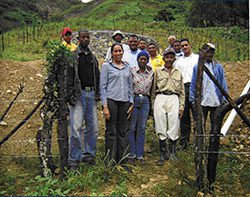 Stories of Systemic Change (This marks the fifth in a series of 10 Vincentian family projects that will be described by Fr. Robert Maloney, Chair of the Systemic Change initiative in the Vincentian Family.)
Stories of Systemic Change (This marks the fifth in a series of 10 Vincentian family projects that will be described by Fr. Robert Maloney, Chair of the Systemic Change initiative in the Vincentian Family.)
5. San José de Ocoa
 Water now flows to over 100 villages, lush and green with new farmland. Nutrition in the area has improved, as has sanitation, and the collaboration between villages fostered teamwork and solidarity among the poor helping the poor. This systemic change project, involving the people of the community of San José de Ocoa, was holistic, and addressed a series of basic human needs.
Water now flows to over 100 villages, lush and green with new farmland. Nutrition in the area has improved, as has sanitation, and the collaboration between villages fostered teamwork and solidarity among the poor helping the poor. This systemic change project, involving the people of the community of San José de Ocoa, was holistic, and addressed a series of basic human needs.
Through the management of water resources, leaders of the project were able to improve health and nutrition, create jobs, and encourage collaboration and a new spiritual life for the people. The project was sustainable because the community itself “owned†it, ensuring the lasting nature of the change for many years to come.
Jack Eshman of Long Island, New York, was not unfamiliar with the plight of the poor. He and his brother and sister Vincentians had often assisted local families in desperate situations, single mothers with limited income, the elderly and the lonely. But when he visited the Ocoa River community in the Dominican Republic, he was shocked at the plight of the entire community: high numbers of infant deaths, lack of sanitation and nutrition, no promise of food from one day to the next. Jack knew he had to help somehow.
 While he was in the Dominican Republic, Jack met a priest named Fr. Louis Quinn who had been serving among the San José de Ocoa community for some time before Jack’s arrival. Fr. Lou was already well acquainted with the needs of the community. He knew that the greatest need was for water, essential for farming and sanitation. He realized that it would, in turn, help resolve the problems of malnutrition and disease. With Fr. Lou’s knowledge and Jack’s connections, the two combined their efforts and consulted the local people to come up with a plan to redirect distant water to the area through a series of aqueducts and pipes.
While he was in the Dominican Republic, Jack met a priest named Fr. Louis Quinn who had been serving among the San José de Ocoa community for some time before Jack’s arrival. Fr. Lou was already well acquainted with the needs of the community. He knew that the greatest need was for water, essential for farming and sanitation. He realized that it would, in turn, help resolve the problems of malnutrition and disease. With Fr. Lou’s knowledge and Jack’s connections, the two combined their efforts and consulted the local people to come up with a plan to redirect distant water to the area through a series of aqueducts and pipes.
Having come up with a joint plan, Jack knew that what he was needed now was money and labor. He decided to establish a “twinning†arrangement with the St. Vincent de Paul Conference in San José de Ocoa. Traditionally, twinning in the Society of St. Vincent de Paul means a process by which resources are sent from one Conference to another, so that the members can give direct assistance to the most needy. But Jack came up with the creative idea of “cluster twinning,†whereby large numbers of conferences and councils in the United States would send twinning support to the project through the San José de Ocoa Conference, and subsequently, to other new conferences in the Dominican Republic.
 With the financial aid brought in through cluster twinning, and with all the villages supplying the labor together, systemic change came to San José de Ocoa. Soon, sums of money were sent for purchasing the equipment needed to build the aqueducts and buy pipes. People in the villages formed work brigades to perform the labor. Eventually, each village helped other neighboring villages with irrigation and land management.
With the financial aid brought in through cluster twinning, and with all the villages supplying the labor together, systemic change came to San José de Ocoa. Soon, sums of money were sent for purchasing the equipment needed to build the aqueducts and buy pipes. People in the villages formed work brigades to perform the labor. Eventually, each village helped other neighboring villages with irrigation and land management.
Water now flows to over 100 villages, lush and green with new farmland. Nutrition in the area has improved, as has sanitation, and the collaboration between villages fostered teamwork and solidarity among the poor helping the poor. This systemic change project, involving the people of the community of San José de Ocoa, was holistic, and addressed a series of basic human needs. Through the management of water resources, leaders of the project were able to improve health and nutrition, create jobs, and encourage collaboration and a new spiritual life for the people. The project was sustainable because the community itself “owned†it, ensuring the lasting nature of the change for many years to come.
Tags: Anti-poverty strategies, Featured
